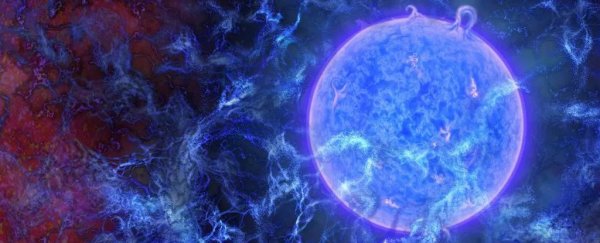We need to talk about the dark ages. No, not those dark ages after the fall of the western Roman Empire. The cosmological dark ages.
The time in our Universe, billions of years ago, before the formation of the first stars. And we need to talk about the cosmic dawn: the birth of those first stars, a tumultuous epoch that completely reshaped the face the cosmos into its modern form.
Those first stars may have been completely unlike anything we see in the present Universe. And we may, if we're lucky, be on the cusp of seeing them for the first time.
The First Black Holes
First we need to set up a little mystery.
We all know by now how black holes come to be. A giant star, somewhere north of eight times the mass of our Sun, lives its brief but predictable life, fusing hydrogen into helium.
Then it runs out of hydrogen and starts fusing helium. Then it runs out of helium and starts burning heavier stuff, making its way up the periodic table until it hits iron. Fusing iron sucks energy instead of releasing energy, and so nothing can stop the terrible gravitational collapse of the star.
Everything gets squeezed down into a tiny volume, and now you have a black hole.
Over time that black hole can meet and consume other black holes, or just suckle on the surrounding interstellar material, increasing in beefiness all the while. Given enough time and enough food, the black hole can swell to become a giant – a supermassive giant. These creatures lurk in the hearts of galaxies, and easily tip the scales at a whopping million-plus times the mass of our Sun.
New material continues to fall in – just because the black hole is gigantic doesn't mean its hunger is sated – and as the gas falls into the gaping maw of the black hole, it compresses and heats up, glowing brighter than a galaxy's worth of stars. This object goes by several names – quasar, blazar, active galactic nucleus – but they all mean the same thing: a giant black hole is feeding.
That's all well and good and slightly terrifying, but here's a problem. We see quasars in the very distant Universe, which means we see quasars in the very young Universe, when it was not even a billion years old (yes, that's young for a universe).
And the process I just described above (forming big stars, letting them live and die, creating a black hole, letting it feed to gargantuan proportions) takes a lot longer than a billion years.
How did our Universe produce monster black holes so quickly?
Fossils of an Ancient Age
If the usual star->black hole->quasar route doesn't seem to work in the early Universe, it's about time to consider alternatives. Shortcuts. Faster routes to creating the big black holes that our observations demand exist. And the quickest way to make a supermassive black hole is to start with a supermassive star.
How supermassive? How about 100,000 solar masses, is that big enough for you?
Stars like that simply don't exist in today's Universe. If you try to cram all that stuff into a compact enough volume to turn it into a star, interactions and instabilities will fragment it like so much crumbling cookie dough in your hands, forming lots of normal stars instead of a single monster one.
This is why we think stars over 100 solar masses are, while possible, exceedingly rare today.
But the era of the Cosmic Dawn was a different time. For one, no heavy elements existed yet – the nuclear forges hadn't been operating for long enough to pollute the interstellar waterways.
Radiation from those extra elements are a great way to cool down a gas cloud and trigger its fragmentation into smaller chunks.
Second, the young cosmos was flooded with high-energy ultraviolet radiation from the sudden birth of other, smaller stars. This radiation breaks apart molecular hydrogen, another key pathway for cooling down and fragmenting a giant gas cloud.
So while again rare, conditions may have been just right at the end of the cosmic dark ages to form giant and even supergiant stars: enough material could have flowed into a small enough volume without splitting apart, giving birth to a huge star.
These giant stars would've led short lives and collapsed directly to form big black holes, shortcutting the usual route to making quasars.
The Cosmic Dawn Breaks
This sounds like a great idea, but in science great ideas need to confront the evidence before we can start believing in them. In this case, it would be pretty handy to have a photograph of one of these gargantuan stars before they turned into black holes and then into quasars.
That's tough, though, because the age when these stars lived and died is far away from us. And those stars, while still giant by stellar standards, were very very small, making them even harder to spot at these extreme distances.
But for once we might get a lucky break. Recent simulations of these strange stars reveal that they are surprisingly cool, having a surface temperature somewhere between 6,000-8000 Kelvin, giving their surfaces an intense red glow. And due to their incredible bulk, they are very bright, bursting with light at an intensity of ten billion Suns.
This combination of sheer brightness and deep redness means that they are potentially visible in infrared wavelengths for some upcoming missions.
Missions like the James Webb Space Telescope, an instrument specifically designed to go hunting for the first stars.
If supergiant stars existed in those long-gone eras, and if some of them were lucky enough to survive into the era where their brethren already started transforming into monster black holes, putting them just a tad closer in view, there's a chance we can directly take their picture.
What a sight that would be.
This article was originally published by Universe Today. Read the original article.
